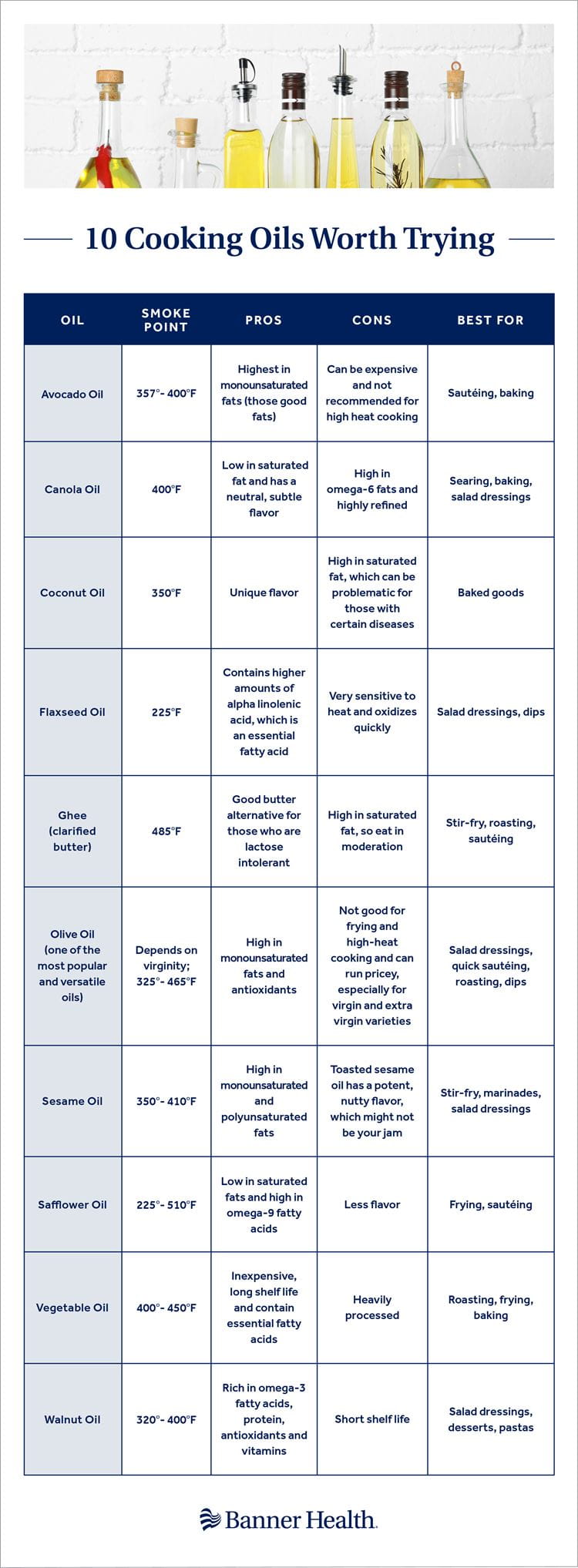Whether making salad dressings and marinades or baking and frying, you’re bound to need oil for your recipe. But with more than 20 options available these days, it may be hard to know where to begin.
Nicole Hahn, a registered dietitian at Banner – University Medical Center Phoenix, breaks down cooking oils for us: their pros, their cons and which ones are the best to use.
Choosing a cooking oil
Before reaching for the olive oil, there are a few things to consider when choosing an oil: nutrition, smoke point and price point.
Nutrition
Cooking oil is classified nutritionally as fat and provides nine calories per gram of fat.
Sources of cooking oils come from plants or animals and contain a unique combination of three types of fat (saturated, monounsaturated and polyunsaturated). Monounsaturated fats, such as olive oil, and polyunsaturated fats, such as safflower oil, are generally free of cholesterol. Saturated fats, which are commonly found in butter and lard, can contribute serious health issues such as obesity and heart disease when consumed in excess.
“Most animal sources of fat have a ratio of 50/50 polyunsaturated and saturated fats, whereas plant sources of fat have a ratio closer to 85/15,” Hahn says. “This makes plant-based fat sources an excellent option for all individuals.”
Smoke Point
The smoke point is the temperature at which the fat starts to burn or degrade. Those with a higher smoke point are best suited for frying and those with a lower smoke point are best suited for marinades and salad dressings.
While smoking oil isn’t always a problem, it can be a sign that you aren’t using the correct oil. Before using any oil, make sure its smoke point can handle the cooking method you plan to use.
“Butter and other animal sources tend to have the lowest smoke points due to the water content in the fat, while vegetable oils like soybean have the highest smoke points,” Hahn says.
Price Point
More expensive oils don’t necessarily equate to higher quality. Some oils, like avocado oil, are pricier because they are harder to find and are only produced in smaller amounts.
Look for oils that come in dark glass bottles, which keep out light and oxygen, and forgo the Costco-size bottle for smaller bottles because some oils don’t keep as long as others. Be sure to also store oils in darker places like a pantry or cupboard.
Now that you know what to look for, here’s a helpful Cooking Oil Cheat Sheet with 10 common cooking oils to help you make the right choice whether you are grilling, baking, marinating or frying.
Would you like more tips on eating healthy? A Banner Health registered dietitian can help you navigate ways to make changes.



